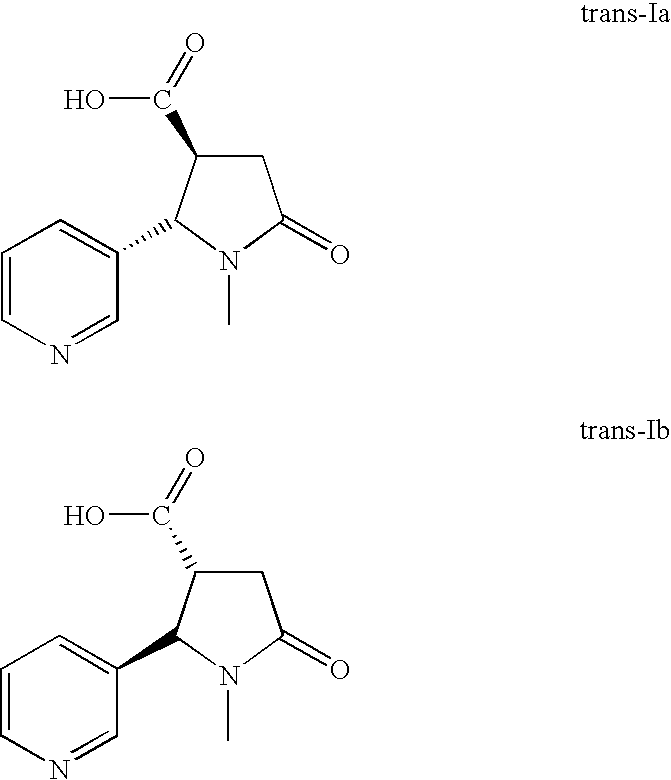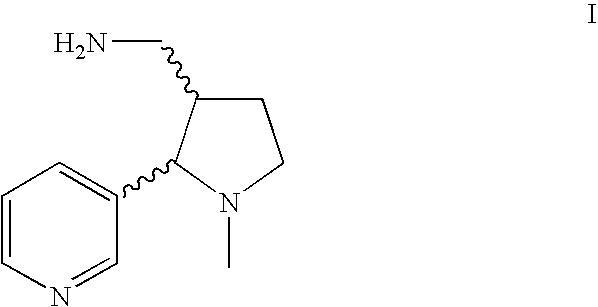Method for making nicotine hapten
a nicotine and cigarette technology, applied in the field of cigarette cigarette making, can solve the problems high smoking rate, and high risk of cardiovascular disease, and achieve the effects of rapid delivery of high arterial concentration, reduced smoking rate, and reduced smoking ra
- Summary
- Abstract
- Description
- Claims
- Application Information
AI Technical Summary
Benefits of technology
Problems solved by technology
Method used
Image
Examples
example 1
Amidation Step (trans-IIIa and trans-IIIb)
[0053]Seventy-five grams of trans-cotininecarboxylic acid (trans-IIa and trans-IIb, 341 mmol, 1 eq.), 37.7 g of ammonium bicarbonate (477 mmol, 1.4 eq.) and 1500 mL of acetonitrile were charged to a reaction flask equipped with a thermometer, a nitrogen bubbler, an addition funnel and a mechanical stirrer. The white thick suspension was stirred for 10-15 min at room temperature (RT) before adding 13.8 mL pyridine (22.7 mmol, 0.5 eq.) in 75 mL acetonitrile. The mixture was stirred for an additional 10-15 min at room temperature before 104.1 g of di-t-butyl dicarbonate (341 mmol, 1.4 eq.) in 300 mL acetonitrile were added dropwise for 15-30 min. When this addition was complete, 37.5 mL of deionized water were added to the mixture. The reaction mixture was then stirred vigorously for 4 hours.
[0054]The reaction was considered complete when residual starting trans-cotininecarboxylic acid was present in less than 1% with respect to the formed amid...
example 2
Amide Reduction Step (trans-Ia and trans-Ib)
[0055]Twelve grams of trans-cotinine amide (trans-IIIa / trans-IIIb, 1 eq.) and 758 mL toluene were charged to a reaction flask equipped with a thermometer, a nitrogen bubbler, an addition funnel and a mechanical stirrer. While applying a moderate agitation to the suspension, 74.1 mL (4.5 eq.) of a Red-Al solution in toluene (65%) were added to the mixture and stirring was continued overnight at room temperature. The progress of the reaction was monitored by HPLC. Typically more than 65% of trans-Ia / trans-Ib was formed.
[0056]The reaction was quenched by adding the mixture to a suspension of 12 g Celite and 6 g of Darco G60 charcoal in 120 mL deionized water. The quenched reaction mixture was filtered through Whatman 11 μm filter paper and the filter cake was washed with 2×24 mL of water. The filtrate was transferred to a separatory funnel and the lower aqueous layer was separated out. This aqueous layer was repeatedly coevaporated with metha...
example 3
Purification Step
[0057]The following preparative chromatography system was used for purifying the crude trans-Ia and trans-Ib obtained from Example 2:
[0058]
HPLC System:Varian Dynamax Preparative HPLCAccessories:One mixer unit, one sample valve, one primingvalvePumps:Two Model SD-1 (flow rates to 800 mL / min)Detector:Model UV-1Detector range:20 AUDetector wavelength:260 nmPurification Column:Novasep 150 mm Ø axial compression columnStationary phase:KromasilMobile phase:Dichloromethane-methanol-ammonia 87:12:0.2by volumeFlow rate:300 mL / minFraction size:2 min (~600 mL)
[0059]After chromatography, each fraction was tested by HPLC to determine the percentage purity in trans-Ia / trans-Ib. Selected fractions with high purity in trans-Ia / trans-Ib were pooled. After pooling and complete solvent evaporation the chromatography yielded 26 to 35% of purified trans-Ia / trans-Ib. The purity of the trans-Ia / trans-Ib was above 97% (less than 2% cis isomer(s)).
[0060]Proton and carbon NMR analysis confir...
PUM
| Property | Measurement | Unit |
|---|---|---|
| purity | aaaaa | aaaaa |
| concentrations | aaaaa | aaaaa |
| molecular weight | aaaaa | aaaaa |
Abstract
Description
Claims
Application Information
 Login to View More
Login to View More - R&D
- Intellectual Property
- Life Sciences
- Materials
- Tech Scout
- Unparalleled Data Quality
- Higher Quality Content
- 60% Fewer Hallucinations
Browse by: Latest US Patents, China's latest patents, Technical Efficacy Thesaurus, Application Domain, Technology Topic, Popular Technical Reports.
© 2025 PatSnap. All rights reserved.Legal|Privacy policy|Modern Slavery Act Transparency Statement|Sitemap|About US| Contact US: help@patsnap.com



